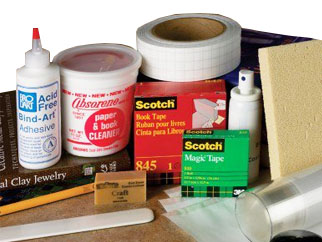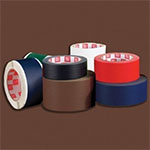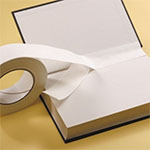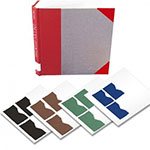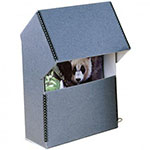We process your personal information to measure and improve our sites and service, to assist our marketing campaigns and to provide personalized content and advertising. By clicking the button on the right, you can exercise your privacy rights. For more information see our privacy notice.
Privacy Policy
A damaged book doesn't have to be the end of its life; instead, use our collection of book repair supplies to fix pages, spines, re-bind, and protect corners of your precious novels, textbooks, history texts, and other hard or paperback books. With a few simple tools and top-quality book care and repair supplies, you can bring new life to your favorite books.
We encourage you to invest in your books now to avoid future damage and additional expenses down the line. Book restoration and repair is a fairly simple process that can quickly and inexpensively restore books to near-original condition with the right tools, saving you money in replacements. Whether you need to repair your own collection of book spines, a library book, or anything in-between, we have all the DIY book repair supplies you'll need to save the day.
Book Repair
Browse our selection of the best book repair tape and full kits to achieve a professional-quality finish. Book repair tape is available in specialized Tyvek options, as well as fabrics, in a variety of colors and sizes. Book repair kits have various supplies and tools so you can repair like the professionals.
Book Protection
Shop our various book care supplies to protect your books from damage and keep them looking like new for longer. Corner protection offers stick-on and wrap-around corner cloths to prevent tearing and bending of the most fragile part of your book, while book covers encapsulate the covers.
Most Popular Book Care & Repair Supplies
Below we have outlined our customer's favorite book repair and protection items; the best of the best options that sell like hotcakes. Libraries, book club members, individuals, museums, book stores, publishers, and anyone else can take advantage of these easy to use supplies.
In an ideal world, our treasured books would remain in pristine condition from the moment they are first cut and bound, until...well, forever. But, if you are avid readers like we are, then you will likely reach a point where the books in your life need some kind of repair to continue functioning. In this section, we will walk you through one of the easiest and strongest ways to fix book binding spines; whether they are slightly coming apart, or the book block has completely fallen out of the cover, this how-to guide can help you.
What Not to Do:
We hope that you have found this page before going rogue and using whatever supplies you just happened to have laying around the house. Traditional hot glue, for example, is a common choice for those who are unfamiliar with binding techniques and may already have it on-hand from their crafting and household use. It does a fantastic job holding together various smooth and textured items, so shouldn't it also work well for some pages and a book cover? Scotch and other household adhesive tapes are also sometimes employed to get the job done; or maybe even super glue, if it is all you have. But these methods and supplies are, unfortunately, not the ideal way to repair your damaged books for long-term use. In fact, these methods can actually damage your books further, wearing down your fragile pages and destroying the integrity of the covers.
How to Repair a Book Spine
- Gather Supplies - First, you should gather the proper supplies and tools to accomplish a proper book repair job. When it comes to re-attaching your book block (the "block" of pages) into the spine of your cover, you will most often need binding glue, a flat item to apply smooth pressure, some way to clamp down the book, and some hinge tape. If your book block is only partially off the cover, you may also need a thin X-Acto knife. For the balance of these instructions, we will assume you are using the recommended supplies below.
We recommend using BroDart acid-free Bind-Art adhesive. This specialized glue is manufactured specifically for the book repair industry, so it the best book repair glue out there. Some of the important features of this adhesive include the flexible texture that allows your pages to turn properly, a chemically stable 7.9 pH level to prevent degradation of your pages, acid-free formulation that is safe for archival books, and a polyvinyl acetate makeup that provides an incredibly strong hold.
For the flat item mentioned, we recommend a bone folder. These handy tools are strong and rigid, so they won't bend or wear out. They offer perfect leverage so you have more control while you work. Bone folders come in several lengths from 6 inches to 9 inches, as well as with rounded or more pointed edges. We prefer at least one pointed edge for a more specific placement. You can also use something like an old popsicle stick, chopstick, or other long, flat item.
For clamping, you can use any number of things. If you plan to repair several books, then you may benefit from a pressure clamp, such as the ChamPadCo 11 inch padding press. A vice such as this provides even pressure along the book-length for a firm hold from edge-to-edge. But if you only need to repair one or a couple of books, you can use several heavier books or even a table clamp from your workroom. Basically, anything that will provide a heavy pressure to the top of your book so the glue can bind properly.
Use hinge repair tape as additional support to connect the cover to the first and last page of your book block. We recommend using EasyBind Tyvek hinge repair tape rolls, as they are the consumer choice for strength and flexibility.
The X-Acto knife will only be needed if your cover has only partially fallen off the pages. - Remove the Book Block - If your book block is only partially fallen off the cover, you will need to remove it the rest of the way. Do not pull it out by hand, as you could tear the pages or cover. Instead, slide your X-Acto knife between the cover and pages and carefully cut through the old binding glue until they separate naturally. If your book block is already off the cover, you can obviously skip this step.
- Apply the Glue - Place a thin strip of repair glue into the spine of your cover. Using the bone folder, spread the glue evenly to each edge of the spine. You can use the pointed edge to get it all the way to the corners as well. The goal of glue application is to create a thin, even application across the spine; you don't want it so thick that it seeps out when you place in your pages, or too thin that it won't hold them together tightly enough.
- Connect the Spine and Pages - Place your cover onto the clamp and slide-in your book block pages. Press them together so they connect well, wrapping the cover completely around your pages. Clamp the book together firmly.
- Let it Dry - Leave the book alone for at least 24 hours so the glue can correctly cure. If you handle your book before this timeframe, the bind will not be strong and our pages might fall right back out.
- Reinforce the Connection - This step is optional, but recommended, especially if you are working with a thicker/heavier book. Apply a strip of Tyvek hinge repair tape to the inside cover where it meets the book block. Do this for both the front and back, attaching the first and last pages to the cover for added support.
Book Repair Tips from the Experts: Librarians


Prevent Damage
We talked with librarians, and their biggest tip always centered around the prevention of damage in the first place. This is not surprising, as their love for books is revealed in their care for books. But when books are not protected by their guardians at the library, they are not subject to the same careful use. And so we've compiled some of the most important tips they recommended:
- Teach your kids/students how to properly care for their books to prevent or delay the need for repair.
- Cover paperbacks with spine and corner tapes.
- Add hinge tape to the inside covers for added support.
- Use book covers or jackets.
Repair Minor Damage Quickly
Before minor tears, bends, and creases before they expand and become a bigger monster to slay. Use book repair tapes for tears in soft covers or breaking ink creases on the spine, or use corner and spine edge protection cloth to hold them together.




Use Proper Repair Supplies
We are a big supporter of BroDart, a major supplier of book care and repair for the library, education, and publishing sectors. We recommend their top-quality supplies for all book repairing needs.
Book covers and corner protectors will help extend the life of your book and prevent further damage. Book repair materials like repair kits, cloth tapes, and flexible adhesives will help you fix damaged books. Our kits come in three options ranging from minimal repair needed to more extensive care and repair to meet your exact needs with ease. While we offer an extensive range of kits to help you restore and repair this beloved item back to the state it deserves, we also offer individual literary binding supplies to help with certain areas of concern. Choose from items such as cloth wings, corner protectors, hinge repair tape, fabric repair in several common colors, and more. Find everything you need with our affordable inventory of high-quality solutions. We offer a large variety of book restoration supplies to help you care for your books and keep them in pristine condition for years of enjoyment.
In this video we show you just how fast and simple it can be to repair the corners of your books, one of the most often damaged parts.
Corner protection cloth has a self-stick back, so all you have to do is peel the liner and stick it to your book. Just line up the V cut-out to the corner of your book, and wrap the edges around to the inside of the covers. Protecting the fragile corners of your hard cover and soft cover books from damage is easy with these cloth stickers, and they can also be used to repair book corners.



